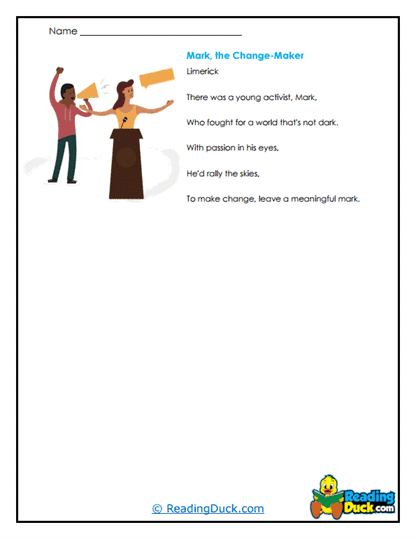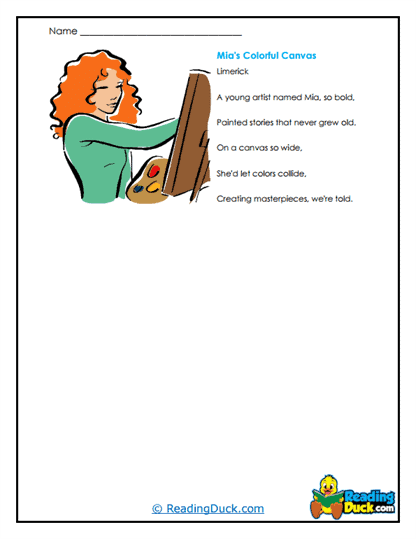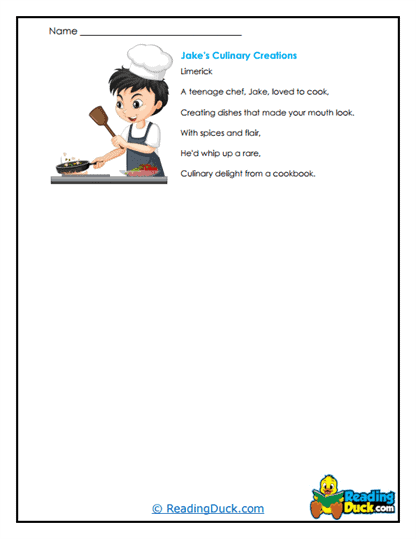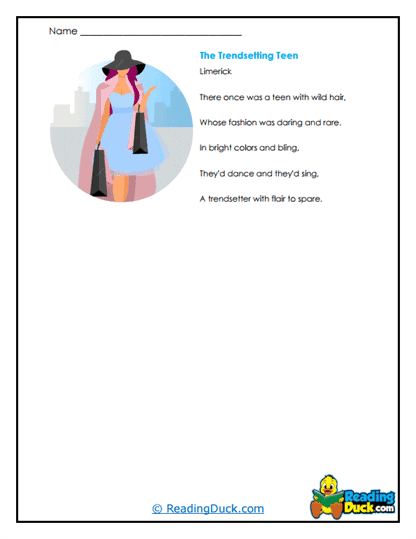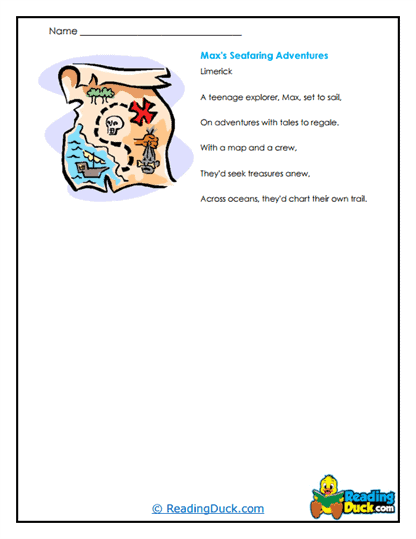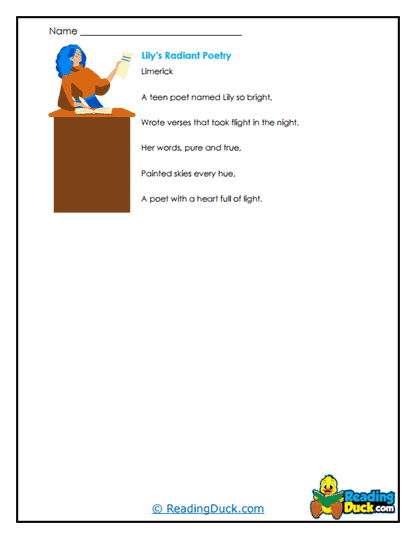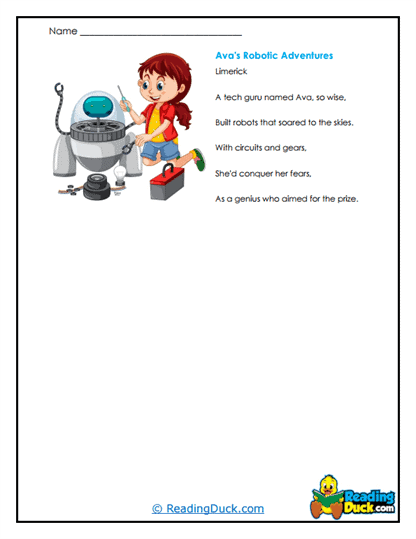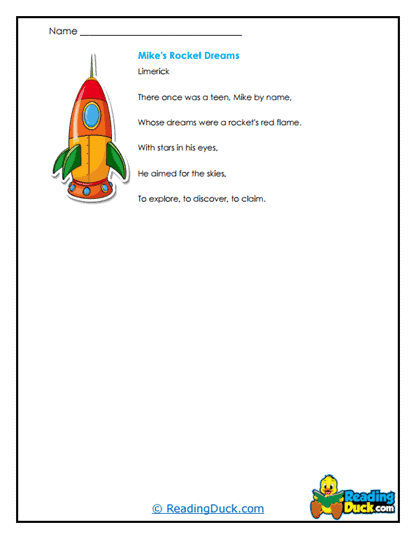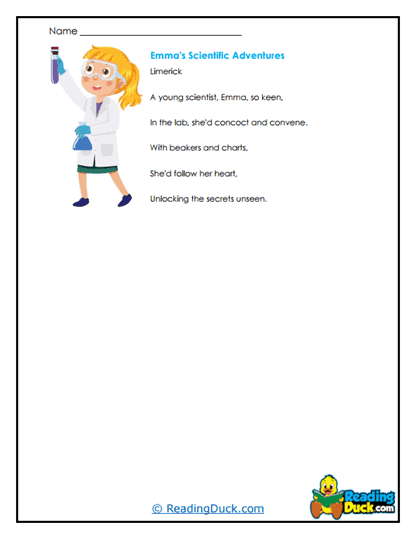Limerick Genre Worksheets
About Our Limerick Genre Worksheets
Our Limerick Genre Worksheets offer students a lively and engaging way to explore one of the most playful forms of poetry. As part of the Reading Poetry category within the Genres section, these worksheets focus on the witty and rhythmic nature of limericks, a genre known for its humorous tone and distinctive five-line structure. Each worksheet set is designed to guide students through the elements of limerick poetry with a variety of question formats, including multiple-choice, short answer, and open-ended responses.
These worksheets are available in PDF format, making them easy to download, print, and use in various educational settings. Each set also comes with a downloadable answer key, streamlining grading and assessment for teachers and homeschoolers alike. Through these engaging exercises, students not only improve their reading comprehension and analytical skills but also experience the joy of crafting their own limericks, tapping into their creative potential.
The Limerick Genre: Humor, Structure, and Cultural Importance
The limerick is a poetic form that originated in the 19th century and is known for its humorous and often nonsensical content. Limericks are short, five-line poems that follow a specific rhyme scheme (AABBA) and have a characteristic rhythm that lends itself to lighthearted, sometimes whimsical storytelling. The rhythm is often described as anapestic or amphibrachic, which gives the limerick its playful, bouncing quality. Limericks are known for being witty and clever, often delivering punchlines in the final line that surprise or amuse the reader.
This genre typically deals with everyday situations, absurd scenarios, or playful exaggerations, making it particularly appealing to younger audiences or those new to poetry. Limericks often feature characters and places that are both imaginative and familiar, allowing readers to connect with the content while enjoying its humor.
The study of limericks is essential to understanding poetry because it introduces students to the technical aspects of rhyme and meter in a fun, accessible way. The structure of a limerick teaches students about syllable patterns, rhyme schemes, and the importance of rhythm in poetry. Furthermore, limericks provide an opportunity for students to experiment with language in a format that encourages creativity and humor, making the learning process both educational and enjoyable.
- Key Themes: Humor, wit, absurdity, and everyday scenarios.
- Characteristics: Five-line structure, AABBA rhyme scheme, consistent rhythm, humorous tone.
- Significance: Limericks make poetry accessible and fun while teaching important lessons about structure and rhyme.
Presented in easy-to-use PDF format, these worksheets are a fantastic tool for both teaching and learning the essentials of limerick poetry, with answer keys included for convenient grading and feedback.
Enhancing Literary Skills Through Limericks
Our Limerick Genre Worksheets are designed to help students develop a variety of critical literary skills, including reading comprehension, critical thinking, and creative expression. The limerick’s short form and playful tone provide an excellent introduction to important concepts such as rhyme, rhythm, and syllable patterns, while also challenging students to think creatively about language.
Each worksheet begins with multiple-choice questions that test students’ comprehension of the poem. These questions focus on key elements such as the rhyme scheme, rhythm, and content of the limerick, helping students solidify their understanding of the poem’s structure. Short answer questions encourage students to explore the technical aspects of the limerick more deeply, such as identifying the number of syllables in each line or explaining how the poem’s rhythm contributes to its overall effect.
Open-ended response questions allow students to engage with the limerick on a more personal level, encouraging them to reflect on the humor or wit of the poem, and how it achieves its intended effect. By analyzing the poem’s structure and language, students develop their ability to interpret and appreciate poetry, while also learning the value of brevity and economy of language.
- Reading Comprehension: Students learn to identify rhyme schemes, rhythm, and the key elements of the poem’s structure.
- Critical Thinking: Analyzing the humor, wit, and structure of the limerick helps students think critically about how language can be used creatively.
- Creative Expression: Open-ended responses encourage students to reflect on their interpretations and engage with the poem’s content.
These worksheets help students build a solid foundation in poetry analysis while providing an enjoyable and accessible way to explore the art of the limerick.
A Flexible Resource for All Learning Environments
The adaptability of our Limerick Genre Worksheets makes them a valuable resource for a variety of educational settings, including traditional classrooms, homeschooling environments, and independent study. Limericks’ simplicity and brevity make them an excellent tool for introducing students to poetry, while their playful nature ensures that the learning process remains fun and engaging.
In classroom settings, these worksheets can be used as part of a broader poetry unit or as a standalone lesson on limericks. Teachers can encourage students to work in groups, discussing the structure and humor of different limericks, or students can create their own limericks based on a specific theme or prompt. Group activities provide opportunities for collaborative learning, while individual assignments allow students to explore their creative abilities at their own pace.
For homeschooling, the worksheets offer a structured yet flexible approach to studying poetry. Parents and educators can tailor the difficulty of the questions to meet their student’s needs, and the open-ended nature of the creative writing exercises allows for personalization and experimentation. Homeschool students can benefit from the worksheets’ focus on both analysis and creation, allowing them to develop their reading comprehension and creative writing skills in tandem.
Independent learners will also find these worksheets accessible and engaging. The PDF format ensures that the worksheets can be easily downloaded and printed, allowing for self-paced learning. The inclusion of an answer key allows students to assess their progress and gain feedback, making these worksheets a valuable tool for self-guided poetry study.
- Classroom Use: Ideal for group discussions, collaborative projects, or individual assignments.
- Homeschooling: Tailorable to different skill levels and learning paces, with an emphasis on creativity.
- Independent Study: Easy-to-use, self-paced worksheets with immediate feedback through answer keys.
No matter the setting, these worksheets offer a versatile and enjoyable way to explore the limerick genre while developing key literary skills.
Fostering Critical Analysis and Deeper Understanding of Poetry
Limerick poetry may be lighthearted, but it provides an excellent opportunity for students to deepen their critical analysis skills and understanding of poetic devices. Our Limerick Genre Worksheets are designed to guide students through the process of closely analyzing the structure, rhythm, and language of limericks, helping them appreciate the technical skill involved in creating such deceptively simple poems.
Through thoughtful, genre-specific questions, students are prompted to consider how the poet uses rhyme, rhythm, and word choice to create humor or surprise. For example, a worksheet might ask students to analyze how the limerick’s punchline works as a resolution to the setup in the first four lines or how the poem’s rhythm contributes to its comedic timing. These questions help students understand that, while limericks are often humorous, they rely on precise language and structure to achieve their effect.
Students also explore the use of literary devices such as metaphor, irony, and hyperbole within the limerick form. By learning to identify these elements in short, structured poems, students gain confidence in their ability to analyze more complex poetry in the future. Close reading exercises encourage students to pay attention to the details of the poem, teaching them to appreciate the craftsmanship involved in creating even the most seemingly simple poems.
- Close Reading: Encourages students to analyze how structure, rhythm, and rhyme contribute to the overall effect of the limerick.
- Literary Devices: Helps students identify the use of metaphor, irony, and exaggeration in limericks.
- Critical Interpretation: Prompts students to think deeply about how humor is created through language.
These worksheets build students’ confidence in poetry analysis, providing a structured yet enjoyable way to engage with the intricacies of limerick poetry.
Encouraging Creative Writing and Experimentation with Form
A central component of our Limerick Genre Worksheets is the opportunity they provide for students to engage in creative writing. Writing limericks allows students to experiment with form, rhythm, and language in a playful and structured way. The brevity and simplicity of the limerick make it an ideal form for students to practice writing, as they can quickly see how their choices in rhyme and rhythm shape the overall effect of the poem.
Each worksheet set includes creative writing prompts that encourage students to compose their own limericks based on a given theme or topic. These exercises help students apply the structural principles they have learned while giving them the freedom to be creative and humorous in their writing. For example, students might be prompted to write a limerick about a character from literature, a place they’ve visited, or an everyday object, using rhyme and rhythm to craft a funny or surprising punchline.
By experimenting with the form, students not only develop their writing skills but also gain a deeper appreciation for how the limerick’s structure influences its meaning. Writing limericks allows students to engage with the poetic form in a hands-on way, reinforcing their understanding of rhyme, meter, and creative expression.
- Writing Prompts: Guided exercises encourage students to write their own limericks based on specific themes.
- Creative Expression: Students learn to play with language and rhythm, crafting humorous or imaginative poems.
- Form Mastery: Writing exercises help students apply the techniques they’ve learned and gain confidence in writing within a structured poetic form.
These creative writing activities provide students with an enjoyable and rewarding way to explore the art of the limerick while developing their own voice as poets.
Conclusion: A Fun and Educational Approach to Exploring Limerick Poetry
Our Limerick Genre Worksheets provide a comprehensive and enjoyable resource for students and educators alike, combining reading comprehension, poetry analysis, and creative writing. Through the study of limericks, students gain valuable insights into the technical aspects of poetry while also experiencing the joy and humor that this form of poetry brings.
Whether used in classrooms, homeschooling settings, or for independent study, these worksheets offer a flexible and accessible way to explore the wit and rhythm of limerick poetry. With guided exercises that focus on reading, analyzing, and writing limericks, students develop essential literary skills while having fun with the creative process.
